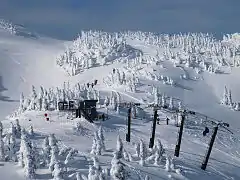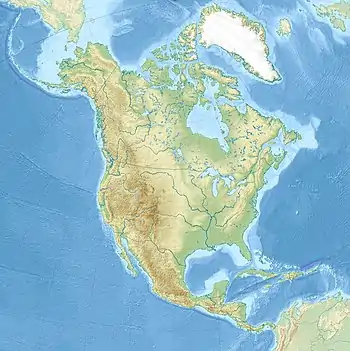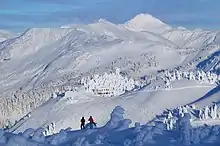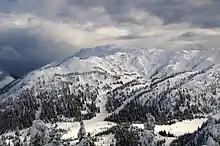Eaglecrest Ski Area
Eaglecrest Ski Area is a public ski area on Douglas Island in the U.S. state of Alaska, across Gastineau Channel from Juneau. The area is owned and operated by Juneau's municipal government. Eaglecrest has 4 double chairlifts accessing 640 acres (2.6 km2), with 36 marked alpine runs, two Nordic skiing loops, and access to world class backcountry. Vertical drop is 1,620 ft (490 m) with an average snowfall of 320" and a record snowfall of 640" in 2011.[1]
| Eaglecrest Ski Area | |
|---|---|
 Black Bear Chair unloading terminal | |
 Eaglecrest Ski Area Location in Alaska  Eaglecrest Ski Area Eaglecrest Ski Area (North America) | |
| Location | Douglas Island,, Alaska |
| Nearest major city | Juneau |
| Coordinates | 58°16′34″N 134°30′55″W |
| Vertical | 1620 ft |
| Top elevation | 2750 |
| Base elevation | 1130 |
| Skiable area | 640 acres (2.6 km2) |
| Runs | 36 |
| Longest run | 2 mi |
| Lift system | 4 chairs |
| Snowfall | 350 in |
| Snowmaking | Yes |
| Website | Eaglecrest Ski Area |
Southeast Alaska's only ski area, Eaglecrest's season generally runs from the first weekend of December through mid-April.[2] In 2018 Eaglecrest made vast improvements to snowmaking systems, mountain trail preparations and general operations to ensure timely openings, even with limited snowfall.[3]
Eaglecrest is family and community oriented, with many community outreach and programs available for skiers and riders of all ages. Eaglecrest's award-winning Snowsports School and certified instructors teach students of all ages the skills they need to be independent and safe skiers and riders. The Adaptive Program offers lessons and guidance to students with physical and learning disabilities.[4]
History
The rich history of skiing in Juneau began in the early 1930s, when skiers would hike for miles then strap slats to their feet to slide down the snowy mountains. From humble beginnings and built from local tax dollars and a lot of community sweat, our "little" ski area now has four double chairlifts, two lodges, robust community programming, Nordic trails, and many of the amenities found at larger ski resorts, including a new bar built in 2019.[5]
Early Juneau Skiing
In the early 1930's rope tows were springing up all over the country, including Juneau. In 1932, a portable tow with 1,000 feet of quarter-inch rope was installed in the Upper Perseverance Trail area, on Alexander (Sandy) Smith's mining claim. There was a 200-yard grassy area in his front yard, which became the first real "ski hill" in Juneau. Skiers could be towed 500 feet up the slope for a great downhill run! Later, Sandy Smith was to become the first president of the Juneau Ski Club when it was formed in 1935.[6][7]
Also in 1935, the Douglas Bridge was built and access to meadow areas on Douglas Island opened up via the Dan Moller Trail, which was constructed by the U.S. Forest Service. The little portable tow was moved to these sites, called 1st Meadow and 2nd Meadow, about 1 1/2 miles up the trail. Forest Service shelters were built which became 1st Cabin and 2nd Cabin. Ten years later, after returning from the U.S. Ski Troops and the 10th Mountain Division, Judge Tom Stewart and others helped to get the Ski Club's first "heavy duty" rope tow going. This was powered by a 1945 Dodge truck engine purchased in Seward for $50, and was set up at the lower 2nd Cabin area. Ski jumping was going on at that time at "Jump Hill" near West Juneau, where hundreds of spectators would go there to see the action, including a downhill race over the Dan Moller Trail.[8]
In the early 1950's the Ski Club's tow was moved to an upper site, which became known as the Douglas Ski Bowl just beyond the Dan Moller Cabin. A warming hut was built by the Ski Club, which became "3rd Cabin." Transportation developed with snowcat operations: a Tucker snowcat christened "Oola, the Juneau Ski Train," and could carry 40-50 skiers with a sled caboose. Shortly after the Ski Club's tow was moved from 2nd Cabin, Al Shaw started a commercial rope-tow operation under the name of Kaw-wah-ee Ski Company, so skiers now had a choice of two rope tow areas. Oola wore out in about ten years and was followed by a snowcat operation that Ink Ingledue started. Formally known as the "Douglas Ski Bowl," skiers could take a ride by snowcat ($2) or helicopter ($5). In 1970, the Ski Club purchased a Snow Master snowcat, which kept running right up to the time of Eaglecrest.[9]
.jpg.webp)
Eaglecrest Formation
With skills honed and appetites whetted by 2nd and 3rd Cabins, it was only a matter of time until Juneau’s skiers hankered for something bigger and better. And in the late 1960's, wheels began turning: the Forest Service did "a little ski area reconnaissance" to see what the options were. Bob Janes and Forest Service/ski patrol colleague Craig Lindh (father of Hilary Lindh, Olympic silver medalist & World Cup Downhill Champion) were assigned the task of surveying suitable sites. They scoped out five areas and preliminarily settled upon the Eaglecrest site (then known as the Fish Creek Drainage) because of accessibility, variety of terrain, exposure, and the fact that a transportation system could be put in without avalanche-path danger.
When the Forest Service put out a prospectus to entice private enterprise to develop the area, the lack of a road kept players away from the table. Along with the substantial efforts of many folks such as Robert Boochever and Fred Eastaugh, lo and behold, in 1971 Alaska’s congressional delegation stepped into the fray to fight for the cause of road access. Thanks to a congressional appropriation of $950,000, which was matched by the Bureau of Outdoor Recreation, road construction started in 1973. Public support for the project was such that in 1974 the ski club members were able to sell Juneau voters on the idea of building the area with monies raised through a 1% sales tax increase.
Lift construction began in 1975 and when the season of 1976-77 rolled around, Eaglecrest Ski Area was up and running with a day lodge, one chairlift and a surface lift. A second lift was added later, with money raised after passage of another sales tax initiative.
The City and Borough of Juneau started in the ski area business much like many other municipalities have - by signing on the dotted line of a special use permit issued by the U.S. Forest Service. But it wouldn't be long before Juneau owned Eaglecrest, lock, stock, and lifts. In 1983, Juneau was able to select the land as part of a state and municipal entitlement program established when Alaska gained statehood in 1959. Hence, Eaglecrest's portion of the Tongass National Forest is owned and operated by the City and Borough of Juneau.
Eaglecrest Today


Eaglecrest now has 36 official alpine runs to go with East & West Bowls, Pittman's Ridge, Hilda & Benches Glades, and 8km of Nordic trails. When snow and staffing allows, the mountain also offers a Terrain Park. Fish Creek Road is now paved and potholes just a deep memory. The Porcupine Lodge, completed in 2015, houses the new Ticket Office, Rental Shop, Ski Shop, and Snowsports School and is conveniently located on the Porcupine Learning Area slopes.[10]
Eaglecrest is a local's mountain in the truest sense of the term, and not just because locals paid for it. Occasionally you will encounter snow riders who have made the trek from Whitehorse, in the Canadian Yukon; Anchorage, some 600 miles away; or from the "Lower 48"... even a few from neighboring Sitka, Petersburg, Ketchikan, or other Southeast Alaska communities; but mostly you will find people at Eaglecrest who share the same zip codes and bump into each other at the grocery stores, restaurants, or the many nocturnal outlets of blues, folk, jazz, and rock & roll music.
Even though Juneau is the state capital and boasts a year-round population of around 30,000 souls, it is accessible only by boat or plane - it is a wild place where ravens rule the streets and store windows advertise bear repellant. As you might expect, this means that Eaglecrest isn't one of those destination resorts whose skier visits rival the population of some countries and whose lift ticket prices brush the upper atmosphere. But because of the diversity of terrain and snow conditions, the locals say that if you can ski at Eaglecrest, you can ski anywhere in the world.
Community Programs
Hilary Lindh Scholarship
The Lindh Scholarship was established in 1992 in recognition of Hilary Lindh’s 1992 Olympic Silver Medal and her dedication to downhill ski racing. Hilary started skiing in Juneau at an early age and won the U.S. and World Junior Championships in Downhill at age 16. She went on to compete in three Olympics and won the 1997 World Downhill Championship before retiring in March of 1997. Hilary was inducted into the U. S. Ski Hall of Fame in 2006 and the Alaska Sports Hall of Fame in 2009. Scholarships will be awarded to one girl and one boy in Grades 1-4, and one boy and one girl in Grades 6-12. The four finalists will receive a complimentary season pass.[11]
5th Grade Passport
Eaglecrest’s 5th Grade Passport provides free lift tickets for all Juneau area fifth grade students, plus one free lesson and one free equipment rental. The student must apply for a Passport online and then visit the ticket window each day to receive a lift ticket.[12]
Learn To Ski Weekend
For 38 years, Eaglecrest has offered Learn To Ski Weekend as an all-expenses-paid weekend on the slopes for Juneau’s 3rd, 4th, and 5th graders! Reserved for students who have never skied before. Selected participants will spend two full days on the mountain having fun, making friends, and learning how to ski![13]
Books2Boards
Books2Boards provides deserving Juneau middle school students with the opportunity to enjoy winter sports at Eaglecrest at no cost. Additionally, Books2Boards students are given access to winter clothing, including jackets, snow pants, gloves, goggles, and helmets. Students for the program are chosen by teachers and staff based on their economic and social need, grades, and attendance. Students must keep good grades, attendance records, and respect school rules. In return, they are provided free lift tickets, rental equipment, lessons, and bus transportation. [14]
References
- "Mountain Info". Eaglecrest Ski Area. Retrieved 2020-10-12.
- "Events Calendar". Eaglecrest Ski Area. Retrieved 2020-10-12.
- "Snowmaking Articles". Eaglecrest Ski Area. Retrieved 2020-10-12.
- "Adaptive Program". Eaglecrest Ski Area. Retrieved 2020-10-12.
- "Dining". Eaglecrest Ski Area. Retrieved 2020-10-12.
- "Perseverance Rope Tow". www.alsap.org. Retrieved 2020-10-12.
- "Evergreen Bowl". www.alsap.org. Retrieved 2020-10-12.
- "Dan Moller Ski Trail / 1st and 2nd Meadow Ski Areas". www.alsap.org. Retrieved 2020-10-12.
- "Douglas Ski Bowl". www.alsap.org. Retrieved 2020-10-12.
- Phu, Lisa (2015-09-20). "Ski area unveils newest addition during Discover Eaglecrest Day". KTOO. Retrieved 2020-10-12.
- "Community". Eaglecrest Ski Area. Retrieved 2020-10-12.
- "Community". Eaglecrest Ski Area. Retrieved 2020-10-12.
- "Community". Eaglecrest Ski Area. Retrieved 2020-10-12.
- "Community". Eaglecrest Ski Area. Retrieved 2020-10-12.
External links
 Media related to Eaglecrest Ski Area at Wikimedia Commons
Media related to Eaglecrest Ski Area at Wikimedia Commons- SkiJuneau.com - official site